
B.Crowell - Vibrations and Waves, Vol
.3.pdf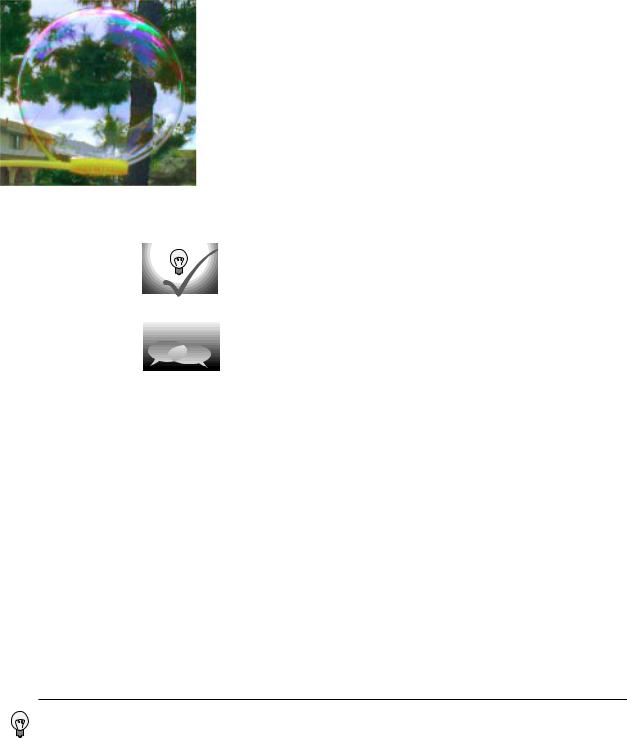
(g) A soap bubble.
This whole analysis applies directly to our original case of optical coatings. Visible light from most sources does consist of a stream of short sinusoidal wave-trains such as the ones drawn above. The only real difference between the waves-on-a-rope example and the case of an optical coating is that the first and third media are air and glass, in which light does not have the same speed. However, the general result is the same as long as the air and the glass have light-wave speeds that either both greater than the coating’s or both less than the coating’s.
The business of optical coatings turns out to be a very arcane one, with a plethora of trade secrets and “black magic” techniques handed down from master to apprentice. Nevertheless, the ideas you have learned about waves in general are sufficient to allow you to come to some definite conclusions without any further technical knowledge. The self-check and discussion questions will direct you along these lines of thought.
The example of an optical coating was typical of a wide variety of wave interference effects. With a little guidance, you are now ready to figure out for yourself other examples such as the rainbow pattern made by a compact disc, a layer of oil on a puddle, or a soap bubble.
Self-Check
1. Color corresponds to wavelength of light waves. Is it possible to choose a thickness for an optical coating that will produce destructive interference for all
colors of light?
2. How can you explain the rainbow colors on the soap bubble in figure g?
Discussion Questions
A. Is it possible to get complete destructive interference in an optical coating,
at least for light of one specific wavelength?
B. Sunlight consists of sinusoidal wave-trains containing on the order of a hundred cycles back-to-back, for a length of something like a tenth of a millimeter. What happens if you try to make an optical coating thicker than this?
C. Suppose you take two microscope slides and lay one on top of the other so that one of its edges is resting on the corresponding edge of the bottom one. If you insert a sliver of paper or a hair at the opposite end, a wedge-shaped layer of air will exist in the middle, with a thickness that changes gradually from one end to the other. What would you expect to see if the slides were illuminated from above by light of a single color? How would this change if you gradually lifted the lower edge of the top slide until the two slides were finally parallel? D. An observation like the one described in the previous discussion question was used by Newton as evidence against the wave theory of light! If Newton didn’t know about inverting and noninverting reflections, what would have seemed inexplicable to him about the region where the air layer had zero or nearly zero thickness?
1. No. To get the best possible interference, the thickness of the coating must be such that the second reflected wave train lags behind the first by an integer number of wavelengths. Optimal performance can therefore only be produced for one specific color of light. The typical greenish color of the coatings shows that it does the worst job for green light. 2. The white sunlight is a mixture of all the colors of the rainbow. A particular color will be reflected more or less depending on the thickness of the soap film in relation to its wavelength. (We have also been assuming that the wave came in perpendicular to the film, but that is not necessarily true here, and that will also have an effect. If the light comes in at an oblique angle, it has to traverse a greater amount of the film.)
Section 4.4 Waves Bounded on Both Sides |
71 |

4.4 Waves Bounded on Both Sides
(a)
We model a guitar string attached to the guitar’s body at both ends as a light-weight string attached to extremely heavy strings at its ends.
(b)
In the example of the previous section, it was theoretically true that a pulse would be trapped permanently in the middle medium, but that pulse was not central to our discussion, and in any case it was weakening severely with each partial reflection. Now consider a guitar string. At its ends it is tied to the body of the instrument itself, and since the body is very massive, the behavior of the waves when they reach the end of the string can be understood in the same way as if the actual guitar string was attached on the ends to strings that were extremely massive. Reflections are most intense when the two media are very dissimilar. Because the wave speed in the body is so radically different from the speed in the string, we should expect nearly 100% reflection.
Although this may seem like a rather bizarre physical model of the actual guitar string, it already tells us something interesting about the behavior of a guitar that we would not otherwise have understood. The body, far from being a passive frame for attaching the strings to, is actually the exit path for the wave energy in the strings. With every reflection, the wave pattern on the string loses a tiny fraction of its energy, which is then conducted through the body and out into the air. (The string has too little cross-section to make sound waves efficiently by itself.) By changing the properties of the body, moreover, we should expect to have an effect on the manner in which sound escapes from the instrument. This is clearly demonstrated by the electric guitar, which has an extremely massive, solid wooden body. Here the dissimilarity between the two wave media is even more pronounced, with the result that wave energy leaks out of the string even more slowly. This is why an electric guitar with no electric pickup can hardly be heard at all, and it is also the reason why notes on an electric guitar can be sustained for longer than notes on an acoustic guitar.
If we initially create a disturbance on a guitar string, how will the
|
reflections behave? In reality, the finger or pick will give the string a triangu- |
|
(c) |
lar shape before letting it go, and we may think of this triangular shape as a |
|
very broad “dent” in the string which will spread out in both directions. For |
||
|
||
|
simplicity, however, let’s just imagine a wave pattern that initially consists of |
|
|
a single, narrow pulse traveling up the neck, (b). After reflection from the |
|
(d) |
top end, it is inverted, (d). Now something interesting happens: figure (f) is |
|
|
identical to figure (b). After two reflections, the pulse has been inverted |
|
|
twice and has changed direction twice. It is now back where it started. The |
|
(e) |
motion is periodic. This is why a guitar produces sounds that have a |
|
definite sensation of pitch. |
||
|
(f)
Self-Check
Notice that from (b) to (f), the pulse has passed by every point on the string exactly twice. This means that the total distance it has traveled equals 2L,
where L is the length of the string. Given this fact, what are the period and frequency of the sound it produces, expressed in terms of L and v, the velocity of the wave? [answer on next page]
72 |
Chapter 4 Bounded Waves |
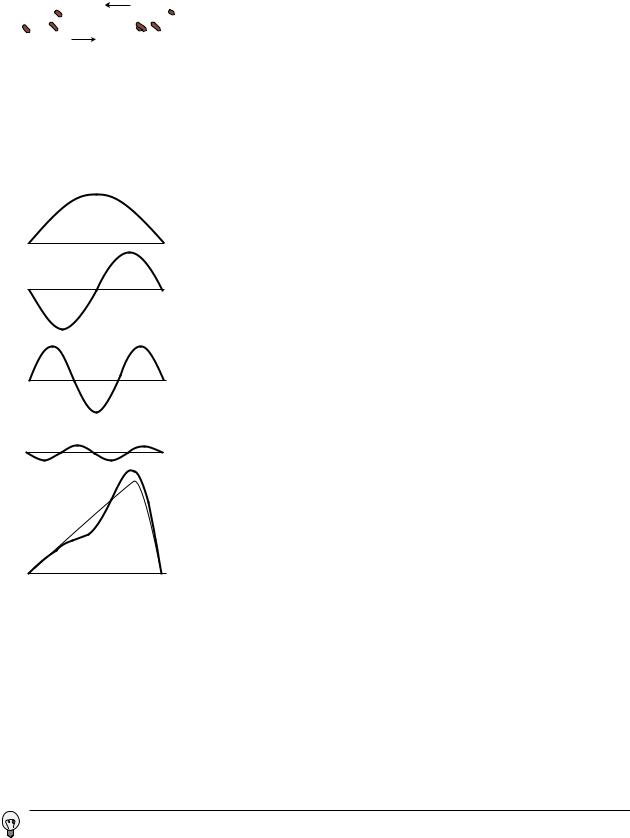
(g) 



fo
2fo
3fo
4fo
sum
Note that if the waves on the string obey the principle of superposition, then the velocity must be independent of amplitude, and the guitar will produce the same pitch regardless of whether it is played loudly or softly. In reality, waves on a string obey the principle of superposition approximately, but not exactly. The guitar, like just about any acoustic instrument, is a little out of tune when played loudly. (The effect is more pronounced for wind instruments than for strings, but wind players are able to compensate for it.)
Now there is only one hole in our reasoning. Suppose we somehow arrange to have an initial setup consisting of two identical pulses heading toward each other, as in figure (g). They will pass through each other, undergo a single inverting reflection, and come back to a configuration in which their positions have been exactly interchanged. This means that the period of vibration is half as long. The frequency is twice as high.
This might seem like a purely academic possibility, since nobody actually plays the guitar with two picks at once! But in fact it is an example of a very general fact about waves that are bounded on both sides. A mathematical theorem called Fourier’s theorem states that any wave can be created by superposing sine waves. The figure on the left shows how even by using only four sine waves with appropriately chosen amplitudes, we can arrive at a sum which is a decent approximation to the realistic triangular shape of a guitar string being plucked. The one-hump wave, in which half a wavelength fits on the string, will behave like the single pulse we originally discussed. We call its frequency fo. The two-hump wave, with one whole wavelength, is very much like the two-pulse example. For the reasons discussed above, its frequency is 2fo. Similarly, the three-hump and fourhump waves have frequencies of 3fo and 4fo.
Theoretically we would need to add together infinitely many such wave patterns to describe the initial triangular shape of the string exactly, although the amplitudes required for the very high frequency parts would be very small, and an excellent approximation could be achieved with as few as ten waves.
We thus arrive at the following very general conclusion. Whenever a wave pattern exists in a medium bounded on both sides by media in which the wave speed is very different, the motion can be broken down into the motion of a (theoretically infinite) series of sine waves, with frequencies fo, 2fo, 3fo, ... Except for some technical details, to be discussed below, this analysis applies to a vast range of sound-producing systems, including the air column within the human vocal tract. Because sounds composed of this kind of pattern of frequencies are so common, our ear-brain system has evolved so as to perceive them as a single, fused sensation of tone.
[answer to self-check on previous page] The period is the time required to travel a distance 2L at speed v, T=2L/v. The frequency is f=1/T=v/2L.
Section 4.4 Waves Bounded on Both Sides |
73 |
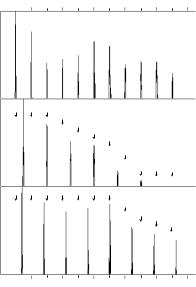
200 400 600 800 1000
G
* |
|
D |
|
|
* |
|
|
* |
x |
x |
C# |
|
|
200 400 600 800 1000 frequency (Hz)
Graphs of loudness versus frequency for the vowel “ah,” sung as three different musical notes. G is consonant with D, since every overtone of G that is close to an overtone of D (*) is at exactly the same frequency. G and C# are dissonant together, since some of the overtones of G (x) are close to, but not right on top of, those of C#.
Musical applications
Many musicians claim to be able to identify individually several of the frequencies above the first one, called overtones or harmonics, but they are kidding themselves. In reality, the overtone series has two important roles in music, neither of which depends on this fictitious ability to “hear out” the individual overtones.
First, the relative strengths of the overtones is an important part of the personality of a sound, called its timbre (rhymes with “amber”). The characteristic tone of the brass instruments, for example, is a sound that starts out with a very strong harmonic series extending up to very high frequencies, but whose higher harmonics die down drastically as the attack changes to the sustained portion of the note.
Second, although the ear cannot separate the individual harmonics of a single musical tone, it is very sensitive to clashes between the overtones of notes played simultaneously, i.e. in harmony. We tend to perceive a combination of notes as being dissonant if they have overtones that are close but not the same. Roughly speaking, strong overtones whose frequencies differ by more than 1% and less than 10% cause the notes to sound dissonant. It is important to realize that the term “dissonance” is not a negative one in music. No matter how long you search the radio dial, you will never hear more than three seconds of music without at least one dissonant combination of notes. Dissonance is a necessary ingredient in the creation of a musical cycle of tension and release. Musically knowledgeable people do not usually use the word “dissonant” as a criticism of music, and if they do, what they are really saying is that the dissonance has been used in a clumsy way, or without providing any contrast between dissonance and consonance.
74 |
Chapter 4 Bounded Waves |
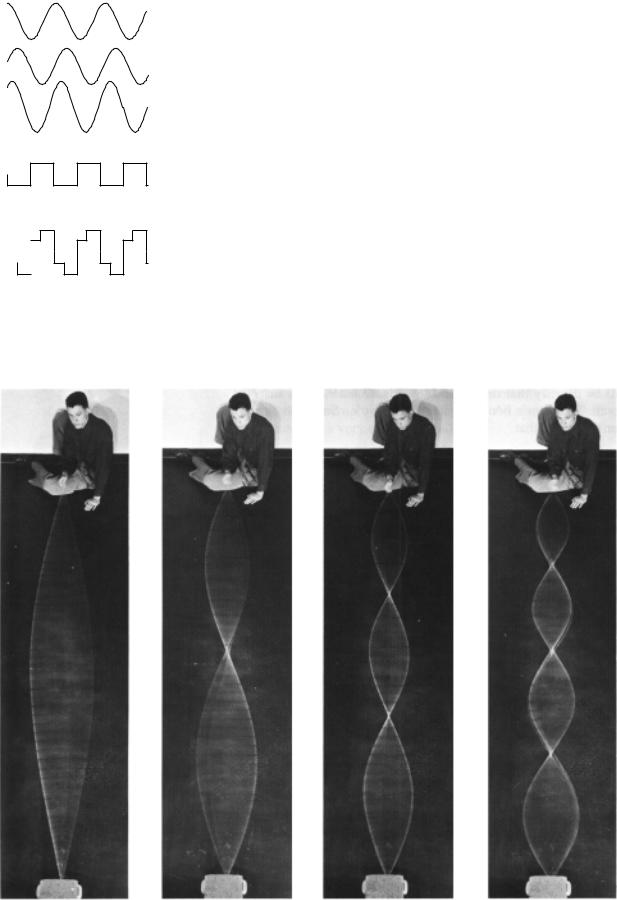
+
=
+ 



= 

If you take a sine wave and make a copy of it shifted over, their sum is still a sine wave. The same is not true for a square wave.
Standing waves
The photos below show sinusoidal wave patterns made by shaking a rope. I used to enjoy doing this at the bank with the pens on chains, back in the days when people actually went to the bank. You might think that I and the person in the photos had to practice for a long time in order to get such nice sine waves. In fact, a sine wave is the only shape that can create this kind of wave pattern, called a standing wave, which simply vibrates back and forth in one place without moving. The sine wave just creates itself automatically when you find the right frequency, because no other shape is possible.
If you think about it, it’s not even obvious that sine waves should be able to do this trick. After all, waves are supposed to travel at a set speed, aren’t they? The speed isn’t supposed to be zero! Well, we can actually think of a standing wave as a superposition of a moving sine wave with its own reflection, which is moving the opposite way. Sine waves have the unique mathematical property that the sum of sine waves of equal wavelength is simply a new sine wave with the same wavelength. As the two sine waves go back and forth, they always cancel perfectly at the ends, and their sum appears to stand still.
Standing wave patterns are rather important, since atoms are really standing-wave patterns of electron waves. You are a standing wave!
(PSSC Physics)
Section 4.4 Waves Bounded on Both Sides |
75 |

Surprisingly, sound waves undergo partial reflection at the open ends of tubes as well as closed ones. The reason has to do with the readjustment of the wave pattern from a plane wave to a spherical wave. If the readjustment was as sudden as that shown in the figure, then there would be kinks in the wave. Waves don’t like to develop kinks. In section 4.2 we deduced the strength of the reflected wave at a change in medium from the requirement that the wave would not have discontinuities or kinks. Here there is no change in medium, but a reflected wave is still required in order to avoid kinks.
closed
open
open
open
closed closed
Graphs of excess density versus position for the lowest-frequency standing waves of three types of air columns. Points on the axis have normal air density.
Standing-wave patterns of air columns
The air column inside a wind instrument or the human vocal tract behaves very much like the wave-on-a-string example we’ve been concentrating on so far, the main difference being that we may have either inverting or noninverting reflections at the ends.
Inverting reflection at one end and uninverting at the other
If you blow over the mouth of a beer bottle to produce a tone, the bottle outlines an air column that is closed at the bottom and open at the top. Sound waves will be reflected at the bottom because of the difference in the speed of sound in air and glass. The speed of sound is greater in glass (because its stiffness more than compensates for its higher density compared to air). Using the type of reasoning outlined in optional section 4.2, we find that this reflection will be density-uninverting: a compression comes back as a compression, and a rarefaction as a rarefaction. There will be strong reflection and very weak transmission, since the difference in speeds is so great. But why do we get a reflection at the mouth of the bottle? There is no change in medium there, and the air inside the bottle is connected to the air in the room. This is a type of reflection that has to do with the threedimensional shape of the sound waves, and cannot be treated the same way as the other types of reflection we have encountered. Since this chapter is supposed to be confined mainly to wave motion in one dimension, and it would take us too far afield here to explain it in detail, but a general justification is given in the caption of the figure.
The important point is that whereas the reflection at the bottom was density-uninverting, the one at the top is density-inverting. This means that at the top of the bottle, a compression superimposes with its own reflection, which is a rarefaction. The two nearly cancel, and so the wave has almost zero amplitude at the mouth of the bottle. The opposite is true at the bottom — here we have a peak in the standing-wave pattern, not a stationary point. The standing wave with the lowest frequency, i.e. the longest wave length, is therefore one in which 1/4 of a wavelength fits along the length of the tube.
Both ends the same
If both ends are open (as in the flute) or both ends closed (as in some organ pipes), then the standing wave pattern must be symmetric. The lowest-frequency wave fits half a wavelength in the tube.
Self-Check
Draw a graph of pressure versus position for the first overtone of the air column in a tube open at one end and closed at the other. This will be the next- to-longest possible wavelength that allows for a point of maximum vibration at one end and a point of no vibration at the other. How many times shorter will its wavelength be compared to the frequency of the lowest-frequency standing wave, shown in the figure? Based on this, how many times greater will its frequency be? [Answer on next page.]
76 |
Chapter 4 Bounded Waves |

Summary
Selected Vocabulary
reflection .......................... |
the bouncing back of part of a wave from a boundary |
transmission ..................... |
the continuation of part of a wave through a boundary |
absorption ........................ |
the gradual conversion of wave energy into heating of the medium |
standing wave .................. |
a wave pattern that stays in one place |
Notation
λ ........................................... wavelength (Greek letter lambda)
Summary
Whenever a wave encounters the boundary between two media in which its speeds are different, part of the wave is reflected and part is transmitted. The reflection is always reversed front-to-back, but may also be inverted in amplitude. Whether the reflection is inverted depends on how the wave speeds in the two media compare, e.g. a wave on a string is uninverted when it is reflected back into a segment of string where its speed is lower. The greater the difference in wave speed between the two media, the greater the fraction of the wave energy that is reflected. Surprisingly, a wave in a dense material like wood will be strongly reflected back into the wood at a wood-air boundary.
A one-dimensional wave confined by highly reflective boundaries on two sides will display motion which is periodic. For example, if both reflections are inverting, the wave will have a period equal to twice the time required to traverse the region, or to that time divided by an integer. An important special case is a sinusoidal wave; in this case, the wave forms a stationary pattern composed of a superposition of sine waves moving in opposite direction.
[Answer to self-check on previous page.] The wave pattern will look like this:  .Three quarters of a wave-
.Three quarters of a wave-
length fit in the tube, so the wavelength is three times shorter than that of the lowest-frequency mode, in which one quarter of a wave fits. Since the wavelength is smaller by a factor of three, the frequency is three times higher. Instead of fo, 2fo, 3fo, 4fo, ..., the pattern of wave frequencies of this air column goes fo, 3fo, 5fo, 7fo, ...
Summary 77

Homework Problems
C261.6 Hz
D293.7
E329.6
F349.2
G392.0
A440.0
Bflat 466.2
Problem 5.
1. Light travels faster in warmer air. Use this fact to explain the formation of a mirage appearing like the shiny surface of a pool of water when there is a layer of hot air above a road.
2. (a) Using the equations from optional section 4.2, compute the amplitude of light that is reflected back into air at an air-water interface, relative to the amplitude of the incident wave. The speeds of light in air and water are 3.0x108 and 2.2x108 m/s, respectively.
(b ) Find the energy of the reflected wave as a fraction of the incident energy. [Hint: The answers to the two parts are not the same.]
3. A B-flat clarinet (the most common kind) produces its lowest note, at about 230 Hz, when half of a wavelength fits inside its tube. Compute the length of the clarinet. [Check: The actual length of a clarinet is about 67 cm from the tip of the mouthpiece to the end of the bell. Because the behavior of the clarinet and its coupling to air outside it is a little more complex than that of a simple tube enclosing a cylindrical air column, your answer will be close to this value, but not exactly equal to it.]
4. (a) A good tenor saxophone player can play all of the following notes without changing her fingering, simply by altering the tightness of her lips: Eb (150 Hz), Eb (300 Hz), Bb (450 Hz), and Eb (600 Hz). How is this possible? (b) Some saxophone players are known for their ability to use this technique to play “freak notes,” i.e. notes above the normal range of the instrument. Why isn’t it possible to play notes below the normal range using this technique?
5. The table gives the frequencies of the notes that make up the key of F major, starting from middle C and going up through all seven notes. (a) Calculate the first five or six harmonics of C and G, and determine whether these two notes will be consonant or dissonant. (b) Do the same for C and B flat. [Hint: Remember that harmonics that differ by about 1- 10% cause dissonance.]
S |
A solution is given in the back of the book. |
↔ A difficult problem. |
|
A computerized answer check is available. |
ò A problem that requires calculus. |
78

Exercises
Exercise 1A: Vibration
Equipment:
air track and carts of two different masses springs
alligator clips meter sticks spring scales stopwatches
spring
cart
air track
Place the cart on the air track and attach springs so that it can vibrate.
1.Test whether the period of vibration depends on amplitude. Try at least two moderate amplitudes, for which the springs do not go slack, and at least one amplitude that is large enough so that they do go slack.
2.Try a cart with a different mass. Does the period change by the expected factor, based on the equation T=2π m / k ?
m / k ?
3.Use a spring scale to pull the cart away from equilibrium, and make a graph of force versus position. Is it linear? If so, what is its slope?
4. Test the equation T=2π m / k numerically.
m / k numerically.
79
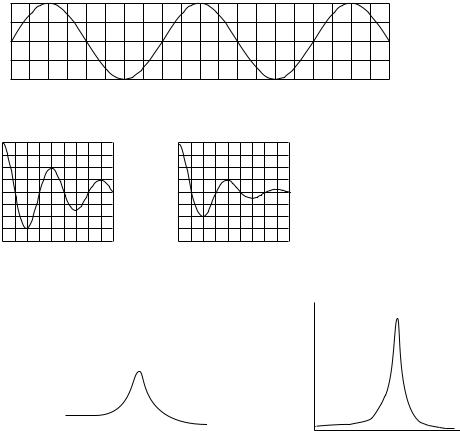
Exercise 2A: Worksheet on Resonance
1. Compare the oscillator’s energies at A, B, C, and D.
A B C D
x
t
2. Compare the Q values of the two oscillators.
x |
x |
t |
t |
3. Match the x-t graphs in #2 with the amplitude-frequency graphs below.
response |
|
response |
|
|
|
frequency |
frequency |
80
